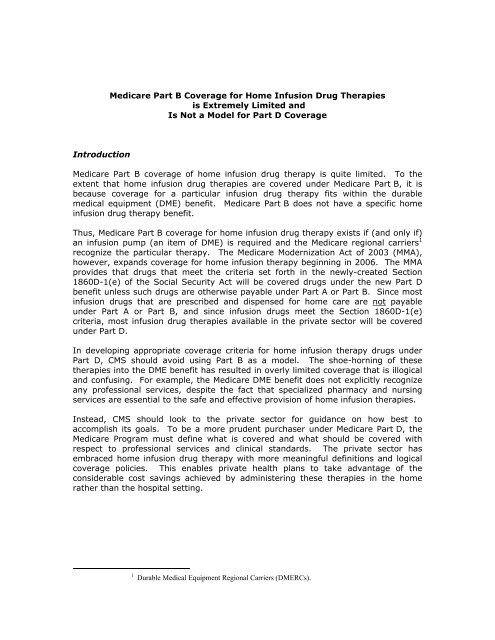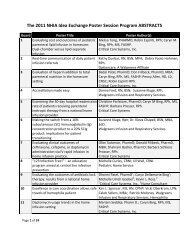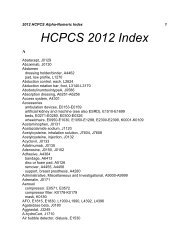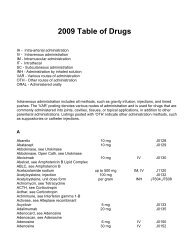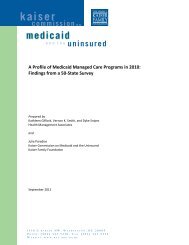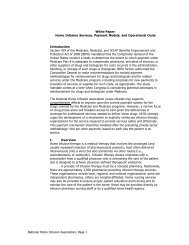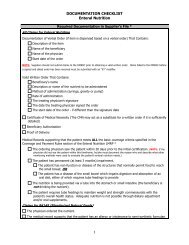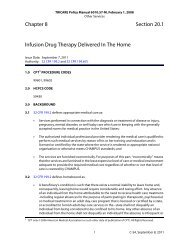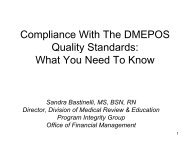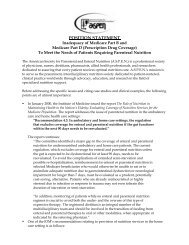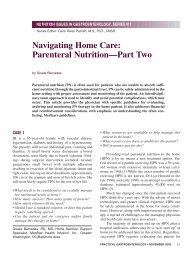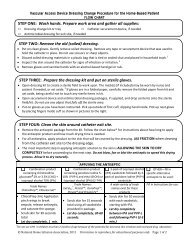Medicare Part B Coverage for Home Infusion Drug Therapies ... - NHIA
Medicare Part B Coverage for Home Infusion Drug Therapies ... - NHIA
Medicare Part B Coverage for Home Infusion Drug Therapies ... - NHIA
Create successful ePaper yourself
Turn your PDF publications into a flip-book with our unique Google optimized e-Paper software.
<strong>Medicare</strong> <strong>Part</strong> B <strong>Coverage</strong> <strong>for</strong> <strong>Home</strong> <strong>Infusion</strong> <strong>Drug</strong> <strong>Therapies</strong>is Extremely Limited andIs Not a Model <strong>for</strong> <strong>Part</strong> D <strong>Coverage</strong>Introduction<strong>Medicare</strong> <strong>Part</strong> B coverage of home infusion drug therapy is quite limited. To theextent that home infusion drug therapies are covered under <strong>Medicare</strong> <strong>Part</strong> B, it isbecause coverage <strong>for</strong> a particular infusion drug therapy fits within the durablemedical equipment (DME) benefit. <strong>Medicare</strong> <strong>Part</strong> B does not have a specific homeinfusion drug therapy benefit.Thus, <strong>Medicare</strong> <strong>Part</strong> B coverage <strong>for</strong> home infusion drug therapy exists if (and only if)an infusion pump (an item of DME) is required and the <strong>Medicare</strong> regional carriers 1recognize the particular therapy. The <strong>Medicare</strong> Modernization Act of 2003 (MMA),however, expands coverage <strong>for</strong> home infusion therapy beginning in 2006. The MMAprovides that drugs that meet the criteria set <strong>for</strong>th in the newly-created Section1860D-1(e) of the Social Security Act will be covered drugs under the new <strong>Part</strong> Dbenefit unless such drugs are otherwise payable under <strong>Part</strong> A or <strong>Part</strong> B. Since mostinfusion drugs that are prescribed and dispensed <strong>for</strong> home care are not payableunder <strong>Part</strong> A or <strong>Part</strong> B, and since infusion drugs meet the Section 1860D-1(e)criteria, most infusion drug therapies available in the private sector will be coveredunder <strong>Part</strong> D.In developing appropriate coverage criteria <strong>for</strong> home infusion therapy drugs under<strong>Part</strong> D, CMS should avoid using <strong>Part</strong> B as a model. The shoe-horning of thesetherapies into the DME benefit has resulted in overly limited coverage that is illogicaland confusing. For example, the <strong>Medicare</strong> DME benefit does not explicitly recognizeany professional services, despite the fact that specialized pharmacy and nursingservices are essential to the safe and effective provision of home infusion therapies.Instead, CMS should look to the private sector <strong>for</strong> guidance on how best toaccomplish its goals. To be a more prudent purchaser under <strong>Medicare</strong> <strong>Part</strong> D, the<strong>Medicare</strong> Program must define what is covered and what should be covered withrespect to professional services and clinical standards. The private sector hasembraced home infusion drug therapy with more meaningful definitions and logicalcoverage policies. This enables private health plans to take advantage of theconsiderable cost savings achieved by administering these therapies in the homerather than the hospital setting.1 Durable Medical Equipment Regional Carriers (DMERCs).
Page - 2Policymakers have not expanded <strong>Part</strong> B coverage of home infusion therapy becauseit was widely accepted that the best means of establishing proper coverage <strong>for</strong> homeinfusion therapy is through passage of a comprehensive <strong>Medicare</strong> outpatientprescription drug benefit, which would include broadened coverage of infusion drugsprovided in the home. That has now happened. The <strong>Part</strong> D benefit is theopportunity to ensure that home infusion drug therapies are widely available to<strong>Medicare</strong> beneficiaries in the same manner they are available to private pay patients.Overview of <strong>Infusion</strong> <strong>Drug</strong> <strong>Therapies</strong> Under <strong>Medicare</strong> <strong>Part</strong> B in the <strong>Home</strong>The coverage of infusion drug therapies in the home setting is currently limited tothe subset of infusion therapies that require use of an infusion pump.Reimbursement is limited to the equipment, drugs and supplies. In contrast, wellestablishedstandards of care in the private sector require that certain pharmacy andnursing services be provided with the administration of home infusion drug therapy.<strong>Medicare</strong> <strong>Part</strong> B, however, does not make separate payment <strong>for</strong> such services andthere are no existing <strong>Medicare</strong> standards that require adherence to these orcomparable standards of care. 2 The recent <strong>Medicare</strong> legislation requires CMS todevelop quality standards <strong>for</strong> therapies covered under the DME benefit, and thisprovides an opportunity <strong>for</strong> CMS to develop meaningful standards that are unique tothe infusion community.The fact that <strong>Part</strong> B coverage in the home setting is limited generally to infusiondrugs that require an external infusion pump 3,4 means that a number of importantinfusion drug therapies that could be provided safely and cost-effectively in the homeare not covered. Non-covered therapies include drug infusions that can be run intothe body intravenously by gravity without the precision of regulating the flow with aninfusion pump. For example, many intravenous antibiotics are not covered in thehome <strong>for</strong> this reason, although private payers regularly cover such therapies (oftensaving the expense of providing coverage in a more expensive inpatient setting).To provide infusion drug therapies in the home under the DME benefit, national<strong>Medicare</strong> policy requires that suppliers obtain state licensure to dispense drugs,which typically is regulated through the state boards of pharmacy. The entities thatprovide these therapies tend to specialize in this area. The services involved inproviding infusion therapy, as well as the pharmacy licensure requirements, makesuppliers of infusion drug therapies readily distinguishable from typical DME suppliersor typical pharmacies.2 The <strong>Medicare</strong> Program does require suppliers of durable medical equipment to meet certain general requirements, butthese supplier standards do not pertain to specific clinical issues such as the provision of infusion therapies.3 The list of infusion drugs covered in the home setting under the DME benefit is limited to the following drugs:amphotericin B; deferoxamine mesylate; hydromorphone; dobutamine hydrochloride; epoprostenol; foscarnet sodium;ganciclovir sodium; insulin; meperidin hydrochloride; milrinone lactate; morphine sulfate; fentanyl citrate; doxorubicinHCL; bleomycin sulfate; cladribine; cytarabine; fluorouracil; floxuridine; acyclovir; vinblastine sulfate; vincristinesulfate. Other drugs might be covered <strong>for</strong> home infusion drug therapy under the appropriate miscellaneous code on anindividual consideration basis, if the regional carriers that handle DME claims (DMERCs) find that the drug requires anexternal infusion pump and the drug is medically necessary.4 Although the primary mechanism <strong>for</strong> coverage of infusion drug therapies in the home is the DME benefit, <strong>for</strong> the sakeof completeness, please note that several infusion drug therapies are covered in the home setting under the applicableregional medical policies <strong>for</strong> immunosuppressive drugs. The list of infusion drugs covered in the home setting underthe DMERC medical policy <strong>for</strong> immunosuppressive drugs is limited to the following drugs: azathioprine andmethlyprednisone sodium succinate.
Page - 3Professional Services and Standards of Care in the <strong>Home</strong> SettingPerhaps as important as stating what is covered expressly under the DME benefit, itis important to highlight that there is no separate payment under <strong>Medicare</strong> <strong>Part</strong> B <strong>for</strong>the professional pharmacy and nursing services required to meet the standards ofcare that are common in the private sector. Payment <strong>for</strong> such functions and costsare subsidized through reimbursement <strong>for</strong> the drugs, equipment, and supplies. Mostobservers, including the General Accounting Office, criticize this approach.Additionally, <strong>Medicare</strong> <strong>Part</strong> B does not en<strong>for</strong>ce or require adherence to any clinicalstandards <strong>for</strong> the provision of home infusion drug therapy, although private sectorpayers often require credentialing or adherence to the standards promulgated by theJoint Commission on Accreditation of Healthcare Organizations (JCAHO) or a similarnational credentialing organization.The Role of <strong>Home</strong> Health AgenciesIt is also worth noting that most home health agencies (HHAs) do not have statepharmacy licenses and do not provide home infusion drug therapies as part of theirrange of services. In the event that beneficiaries who qualify <strong>for</strong> care under the HHAbenefit (<strong>for</strong> example, they meet the Program’s definition of “homebound”) alsorequire home infusion drugs, the infusion drug therapy usually is provided by asupplier specializing in this area that maintains proper state pharmacy licensure.The infusion therapy would be covered by <strong>Medicare</strong> separate and apart from theservices covered under the HHA benefit. There are, of course, HHAs that haveestablished pharmacies and can offer infusion therapy drugs and services.It also is important to note that private health plans designate the home infusionpharmacy as the primary provider <strong>for</strong> patients requiring infusion drug therapy – nothome health agencies – because the home infusion provider is expert in the clinicalmanagement and care coordination of these patients. <strong>Home</strong> infusion pharmacies arerequired to meet distinct standards that are vital to safe and effective infusion care.ConclusionThe benefit methodology in <strong>Medicare</strong> <strong>Part</strong> B coverage <strong>for</strong> infusion drug therapies isnot suitable <strong>for</strong> implementation of the new infusion drug coverage under <strong>Part</strong> D. TheDME benefit is designed to compensate DME suppliers <strong>for</strong> the provision of medicalequipment. In contrast, home infusion providers also must provide professionalpharmacy and other clinical services to achieve good patient outcomes. For thatreason, the vast majority of private sector payers require accreditation <strong>for</strong> homeinfusion providers.The lack of any separate payments <strong>for</strong> administration of infusion drug therapy in thehome setting to cover the professional pharmacy or nursing services makeshomecare providers especially vulnerable to pricing changes <strong>for</strong> those components ofthe therapy that are covered (<strong>for</strong> example, the drugs). This aspect of home infusiontherapy is distinguishable from infusion therapy provided in physician office settingswhere separate codes and fees do exist <strong>for</strong> the administration of infusion drugtherapy. We believe that, in recognition of this vulnerability <strong>for</strong> home infusion drugtherapy under <strong>Medicare</strong> <strong>Part</strong> B, Congress left reimbursement <strong>for</strong> the drug componentof home infusion drug therapy untouched in the near future.
Page - 4Thus, we believe it is important to recognize that the existing limited coverage model<strong>for</strong> some infusion drug therapies under <strong>Medicare</strong> <strong>Part</strong> B is an antiquated model thatis inconsistent with the approach used by private payers. To ensure meaningfulaccess <strong>for</strong> beneficiaries to home infusion drug therapy, the <strong>Medicare</strong> program shouldlook to the well-established private sector coverage in its roll out of <strong>Part</strong> D coverage<strong>for</strong> home infusion drug therapy.* * * *For further in<strong>for</strong>mation, please do not hesitate to contact Alan Parver (202-624-7225or aparver@pgfm.com) or Lorrie Kaplan (703 838-2658 orlorrie.kaplan@ncpanet.org).


